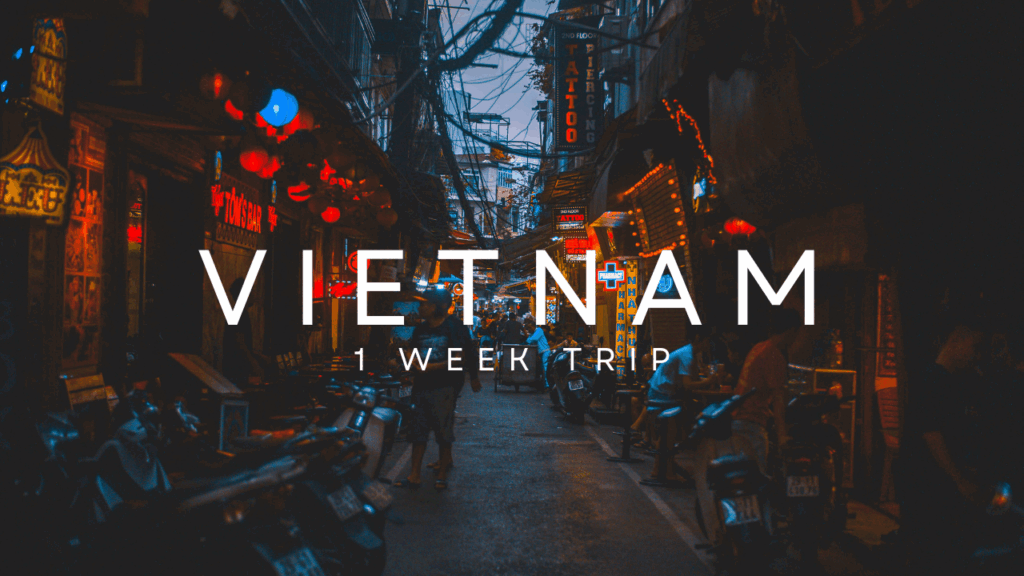If you only have one week to explore Vietnam, prioritizing key destinations is essential. My recommendation is to split your time between Hanoi, Ha Long Bay, and Hoi An to experience the country’s culture, natural beauty, and history efficiently. This plan gives a balanced glimpse of both urban life and stunning landscapes.
Vietnam offers more than just sights—it’s about savoring the food, meeting locals, and understanding its rich past. I’ll guide you through the best spots and activities that fit neatly into a seven-day trip. This way, you won’t waste time and can enjoy what Vietnam truly has to offer.
Planning Your One-Week Vietnam Itinerary
To make the most of one week in Vietnam, I focus on timing, getting between places efficiently, and preparing for the local culture and conditions. These elements shape how smoothly my trip goes and how much I experience.
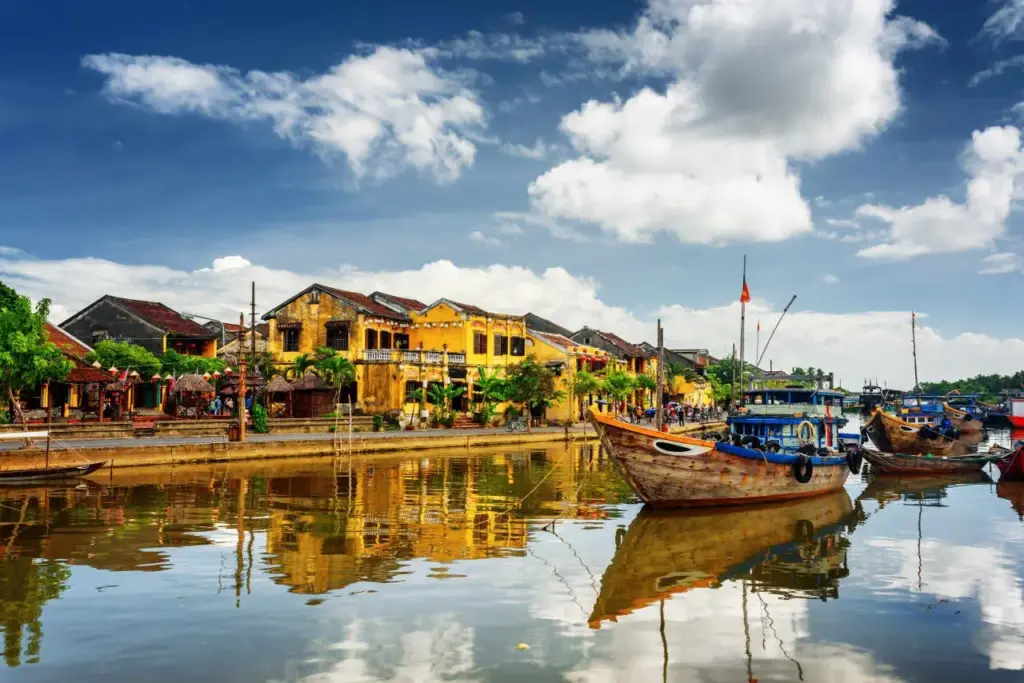
READ MORE: Amazing Things to Do in Vermont
Best Time to Visit Vietnam
Vietnam’s weather varies a lot depending on the region, so I plan trips according to where I’ll be. The north is best from October to December when it’s cooler and dry. Hanoi and Ha Long Bay shine during this period.
The south, including Ho Chi Minh City and the Mekong Delta, is warm year-round but less rainy from December to April. Central Vietnam, around Hue and Da Nang, has its best weather in February and March before the rainy season starts mid-year.
I avoid the rainy season in each region because heavy rain can disrupt sightseeing and travel plans.
Transportation Between Destinations
I rely on flights for longer distances to save time. Vietnam has several budget airlines like VietJet Air and Bamboo Airways offering frequent routes between Hanoi, Da Nang, and Ho Chi Minh City.
For shorter trips, I prefer trains or buses. The Reunification Express train is comfortable and scenic between Hanoi and Hue or Da Nang. Buses are more budget-friendly but less comfortable.
Within cities, I use Grab (a ride-hailing app) or cyclos for short distances. Motorbike rentals provide flexibility but require confident riding.
Essential Travel Tips for First-Time Visitors
I always carry local currency (Vietnamese dong) in cash since small vendors rarely accept cards. ATMs are widespread in cities but less common in rural areas.
Street food is safe if you pick busy stalls. I choose freshly cooked dishes like pho or banh mi to avoid risk.
Vietnam drives on the right side. Crossing streets requires careful observation and steady walking, as traffic can be hectic.
I bring a universal power adapter; Vietnam uses type A, C, and D outlets typically at 220V. Also, a lightweight raincoat or umbrella helps during unexpected showers.
Top Destinations for 1 Week in Vietnam
In one week, you can explore a mix of vibrant cities, stunning natural landscapes, and culturally rich towns. Each destination offers unique experiences that reflect Vietnam’s diverse history and environment.
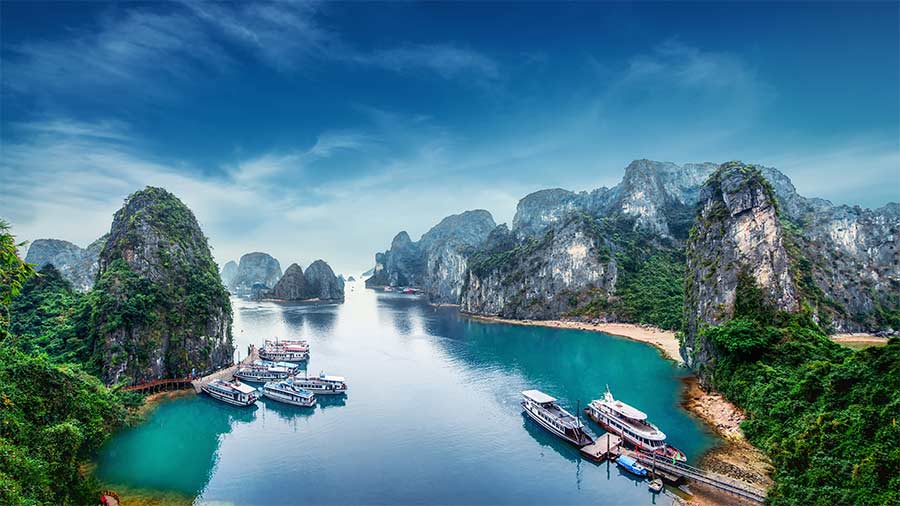
Hanoi: Culture and Cuisine
In Hanoi, I focus on the Old Quarter for its bustling streets and authentic street food. The area is packed with vendors selling pho, banh mi, and egg coffee. I always make sure to visit the Hoan Kiem Lake early in the morning to see local tai chi practitioners.
Cultural landmarks like the Temple of Literature and the Ho Chi Minh Mausoleum offer deep historical insight. Museums and colonial architecture add to the experience. I find walking tours the best way to understand Hanoi’s blend of tradition and modern life.
Halong Bay: Cruises and Natural Wonders
Halong Bay is famous for its limestone karsts and emerald waters. I prefer an overnight cruise to maximize time among the islands. Most cruises include activities like kayaking, cave exploration, and visiting floating villages.
Choosing a smaller boat means less crowding and more personalized service. I recommend packing light and bringing swimwear for spontaneous dips. The sunsets here are a quiet, natural spectacle that contrasts Hanoi’s urban energy.
Hoi An: Ancient Town Experience
Hoi An’s UNESCO-listed Ancient Town features well-preserved architecture from different periods and cultures. I enjoy cycling through the scenic streets lined with lantern-lit cafes and tailor shops. It’s a place to slow down and appreciate detailed craftsmanship in wood and silk.
I always try local specialties such as Cao Lau noodles and white rose dumplings. Evening river views and night markets offer a relaxed atmosphere to end the day. The nearby beaches provide a good option to unwind after several days of sightseeing.
Recommended 7-Day Vietnam Itinerary Options
Each itinerary covers distinct regions with a focus on historic sites, natural beauty, and cultural experiences. You can choose to explore from the north down to the south, stay concentrated in the north, or delve into the central coast for a mix of city and beach time.
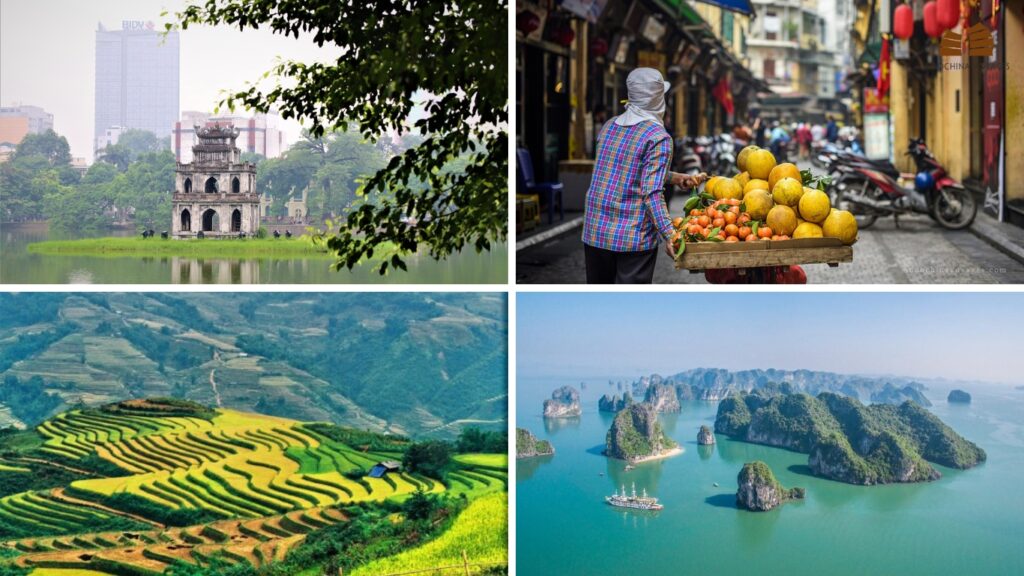
Classic North to South Route
I start in Hanoi, spending two days exploring the Old Quarter, Hoan Kiem Lake, and the Temple of Literature. On day three, I take a day trip to Ha Long Bay for an iconic cruise among limestone islands.
Next, I fly to Da Nang and spend two days in Hoi An. I focus on its lantern-lit streets, historic architecture, and local markets. On day six, I visit the ancient Cham ruins at My Son.
Finally, I conclude in Ho Chi Minh City with one full day to visit the War Remnants Museum, Ben Thanh Market, and the Cu Chi Tunnels nearby. This route offers a broad survey of Vietnam’s diversity.
Northern Highlights Focus
I concentrate on Hanoi and its surroundings. After touring Hanoi for two days, I dedicate two full days to trekking and homestays in Sapa to experience ethnic minority cultures and mountain landscapes.
On the fifth day, I return to Hanoi and then spend a day cruising in Ninh Binh, often called “Halong Bay on land,” with its limestone karsts and river boat rides. The last day involves local street food tours and visiting cultural sites missed earlier.
This itinerary suits travelers wanting depth in the north with a mix of urban and nature experiences without rushing between distant regions.
Central Vietnam Adventure
I begin in Hue for two days to explore the Imperial City, royal tombs, and pagodas. On day three, I drive along the scenic Hai Van Pass to Da Nang, stopping at Marble Mountains.
Hoi An gets two full days for a slower pace: ancient town walks, riverboat rides, and time on nearby An Bang Beach. I include a visit to a local cooking class to learn central Vietnamese flavors.
The final two days are in Phong Nha-Ke Bang National Park to explore impressive caves like Paradise Cave or Son Doong if permits are possible. This itinerary balances history, culture, and nature with less hectic travel.
Must-See Attractions and Activities
Vietnam offers a mix of cultural heritage, natural beauty, and lively urban experiences. I found key highlights include historical sites, outdoor activities, and diverse nightlife options. Each caters to different interests but paints a complete picture of what Vietnam has to offer in a week.

Historical Landmarks in Vietnam
I started at the Imperial City of Hue, a UNESCO World Heritage site. It features ancient palaces, temples, and the Forbidden Purple City. The rich history of the Nguyen Dynasty is evident in the architecture and artifacts.
In Hanoi, the Ho Chi Minh Mausoleum and the nearby One Pillar Pagoda gave me insight into Vietnam’s modern history and spiritual traditions. The War Remnants Museum in Ho Chi Minh City also left a strong impression with exhibits on the Vietnam War.
Don’t miss My Son Sanctuary near Hoi An, where ancient Cham temples stand amid forest. These sites reflect Vietnam’s diverse historic periods and were important cultural hubs.
Outdoor Adventures and Nature
I explored Ha Long Bay by boat, admiring limestone karsts and emerald waters. The boat tours ranged from a few hours to overnight trips, offering kayaking and cave visits. It’s a must for nature lovers.
In the north, trekking in Sapa showed me terraced rice fields and minority villages. The cool climate and scenic mountain views made it a refreshing change from the cities.
For beaches, Da Nang and Phu Quoc Island provide sunbathing and water sports. I found snorkeling and diving particularly rewarding on Phu Quoc, thanks to the coral reefs and marine life.
Nightlife and Entertainment
Ho Chi Minh City has a vibrant nightlife with rooftop bars like Saigon Skydeck and clubs in District 1. I enjoyed live music venues and night markets for local snacks and crafts.
Hanoi’s Old Quarter offers a more relaxed evening vibe with street food stalls, coffee shops, and traditional water puppet shows. I found the night markets lively, perfect for people-watching and shopping.
In coastal areas like Nha Trang, nightlife revolves around beach bars and nightclubs. The mix of tourists and locals creates an energetic setting that lasts until late.
Food and Culinary Experiences
Vietnam offers rich and varied flavors, from simple street dishes to hands-on cooking lessons. Exploring these different experiences helped me understand the culture deeply through its food.

Vietnamese Street Food Must-Trys
I found that some street foods are essential to sample. Pho, the famous beef noodle soup, is a staple at dawn and dusk. Banh Mi, a crispy baguette sandwich filled with savory meats and pickled vegetables, was my go-to quick meal.
Other favorites include Goi Cuon (fresh spring rolls) and Bun Cha, grilled pork with noodles, especially popular in Hanoi. I recommend trying Che, a sweet dessert made from beans, fruits, and coconut milk, to finish your street food exploration. Vendors often use fresh ingredients and traditional recipes that have stayed consistent for decades.
Local Markets and Cooking Classes
Visiting local markets revealed the fresh herbs, spices, and produce fundamental to Vietnamese cuisine. I saw how sellers display vibrant vegetables such as lemongrass and Thai basil, as well as fresh seafood and meats. It’s a sensory experience I found valuable before cooking.
Joining a cooking class was a highlight. I learned to prepare classic dishes like Banh Xeo (Vietnamese savory pancakes) and enjoyed the step-by-step guidance. These classes often include market tours, giving context to the ingredients and encouraging interaction with local sellers. Classes typically last 3-4 hours, balancing education and enjoyment.
Cultural Etiquette and Responsible Travel
I found that understanding local customs and adopting eco-friendly habits greatly improved my experience in Vietnam. Respecting traditions and minimizing environmental impact go hand in hand for a responsible and respectful trip.

Local Customs and Manners
In Vietnam, greetings are polite but subtle. I learned to avoid loud voices and public displays of anger, as they are frowned upon.
When visiting temples, removing shoes and dressing modestly is required. I also noticed that pointing with my finger is considered rude; instead, I used my whole hand to gesture.
Tipping is appreciated but not mandatory. I generally left small tips in restaurants or to drivers when service was good.
Always show respect to elders by using both hands when giving or receiving something. Making direct eye contact too long can be seen as aggressive, so I kept it brief and friendly.
Eco-Friendly Practices for Tourists
I made sure to reduce plastic use by carrying a reusable water bottle. Vietnam struggles with plastic waste, so this small change helped.
When exploring nature, I stayed on marked trails to protect local wildlife and plants. I avoided touching or removing anything from natural sites like Ha Long Bay or national parks.
It’s best to support local businesses by buying handmade goods rather than mass-produced souvenirs. This helps the community while lowering environmental costs.
Finally, I used public transportation or cycling when possible. Motorbikes are common, but I preferred options that reduced emissions and traffic congestion.
Practical Tips for a Seamless Trip
I found that managing money wisely and choosing the right place to stay were key to a smooth visit in Vietnam. Paying close attention to currency exchange and accommodation options saved me time and unexpected expenses.

Budgeting and Money Matters
Vietnamese dong (VND) is the local currency, and I always exchanged money at official banks or reputable exchange offices for better rates. ATMs are widely available, but I withdrew moderate amounts to avoid high fees. Cash is king, especially in markets and small shops, so I carried enough for daily expenses.
Credit cards work in bigger cities and hotels but rarely in rural areas. I kept a small amount of USD as a backup; it’s accepted in some places but not always preferred.
Tipping isn’t mandatory but appreciated. I usually left 5-10% in restaurants or rounded up taxi fares. I recommend budgeting around 1,200,000-1,500,000 VND ($50-$65) per day depending on your activities and meals.
Accommodation Recommendations
I typically booked hotels or guesthouses through trusted platforms before arrival to avoid last-minute hassles. Major cities like Hanoi and Ho Chi Minh City offer a wide range from budget hostels ($10-$15 per night) to mid-range hotels ($30-$60 per night).
If you want to experience local charm, I suggest staying in boutique guesthouses or homestays, especially in places like Hoi An or Sapa. These often include breakfasts and more personal interactions.
For convenience, I chose accommodations close to city centers or major attractions to reduce transport time. Checking recent reviews helped me avoid places with poor service or cleanliness issues.
Unique Souvenirs and Shopping in Vietnam
When I shop in Vietnam, I look for items that reflect the country’s culture and craftsmanship. Markets and small shops across cities offer a wide range of unique souvenirs. I find it best to explore local markets where bargaining is common.
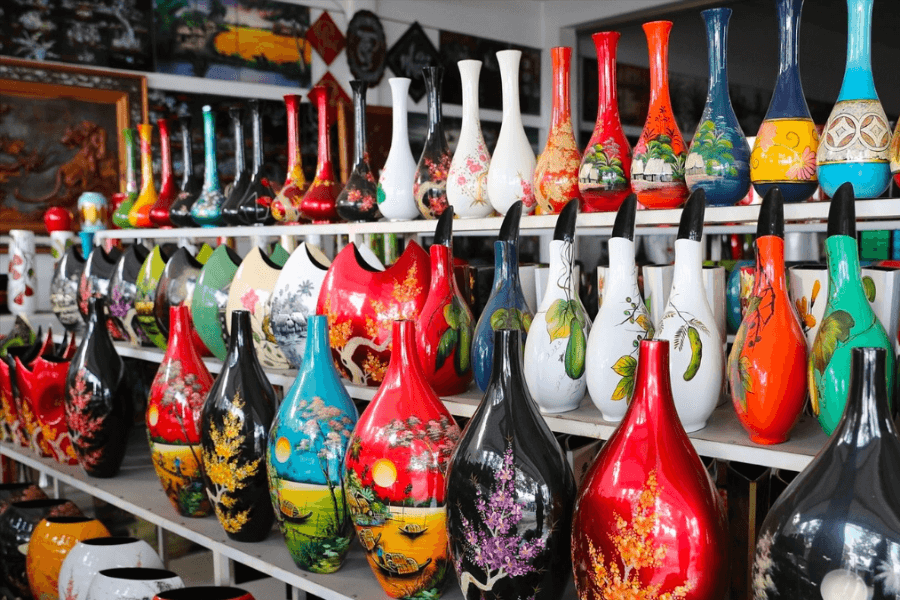
I always pick up silk products like scarves or ties. Vietnamese silk is soft and comes in vibrant colors. It’s lightweight and easy to carry, making it a practical gift.
Another favorite is handmade ceramics. These often feature traditional patterns and are widely available in places like Bat Trang village near Hanoi. They make excellent home decor.
I also enjoy buying coffee, especially from regions like Buon Ma Thuot. Vietnamese coffee has a distinct flavor, and you can buy drip filters to brew it at home. It’s a simple but authentic souvenir.
For something smaller, I look for lacquerware. These glossy items come in bowls, trays, and jewelry boxes. They show remarkable detail and workshop skill.
Here’s a quick list of must-buy items:
- Silk scarves and garments
- Handmade pottery and ceramics
- Vietnamese coffee and drip filters
- Lacquerware
- Traditional conical hats (nón lá)
- Embroidered fabrics and bags
I advise visiting markets such as Ben Thanh in Ho Chi Minh City and Dong Xuan in Hanoi to find these goods. Shopping there offers a genuine experience and good prices if you negotiate well.

